D Link TW1130 Wireless VPN Router User Manual di714P manual 1 31
D Link Corporation Wireless VPN Router di714P manual 1 31
D Link >
Contents
User Manual Part 4
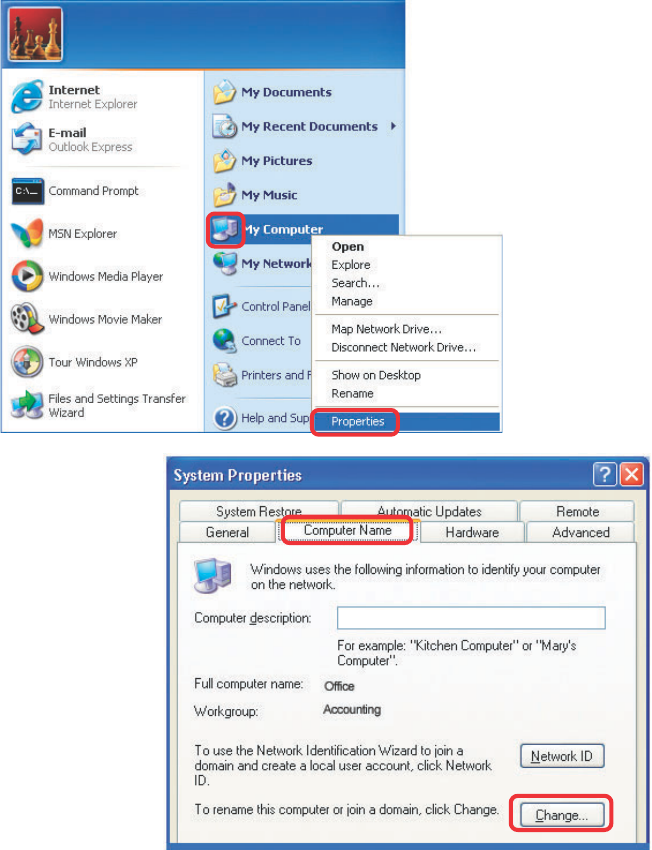
76
Networking Basics
Naming your Computer
To name your computer, please follow these directions: In Windows XP:
Select the Computer
Name Tab in the System
Properties window.
You may enter a Com-
puter Description if you
wish; this field is optional.
To rename the computer
and join a domain, Click
Change.
Click Start (in the lower left corner of the screen).
Right-click on My Computer.
Select Properties and click.
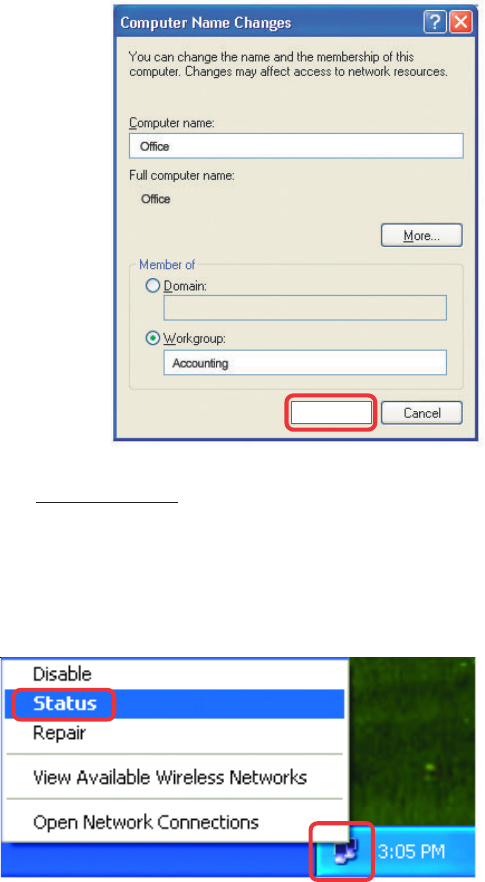
77
Networking Basics
Naming your Computer
In this window, enter the
Computer name.
Select Workgroup and enter
the name of the Workgroup.
All computers on your network
must have the same
Workgroup name.
Click OK.
Checking the IP Address in Windows XP
The wireless adapter-equipped computers in your network must be in the same IP Ad-
dress range (see Getting Started in this manual for a definition of IP Address Range). To
check on the IP Address of the adapter, please do the following:
Right-click on the
Local Area
Connection icon
in the task bar.
Click on Status.
OK
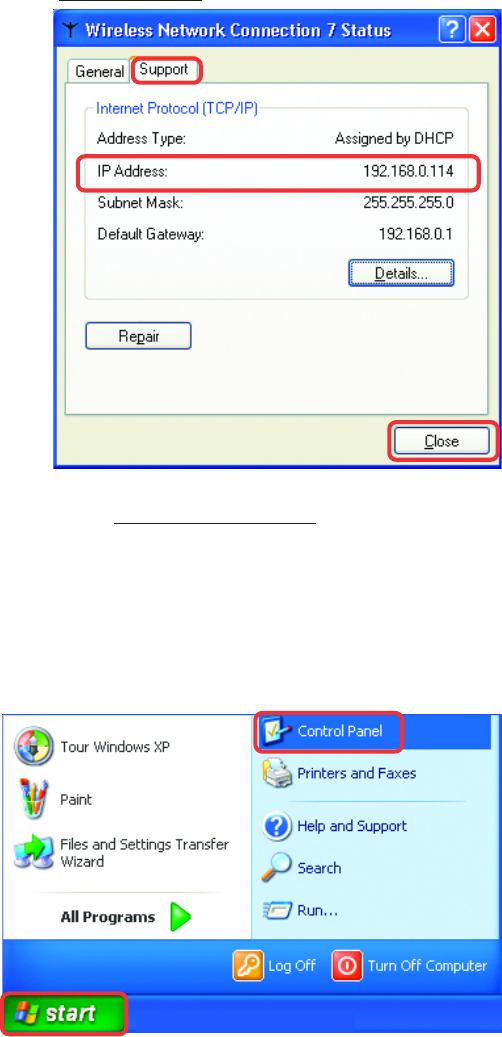
78
Networking Basics
Checking the IP Address in Windows XP
This window will appear.
Click the
Support tab.
Click Close.
Assigning a Static IP Address in Windows XP/2000
Note: Residential Gateways/Broadband Routers will automatically assign IP Ad-
dresses to the computers on the network, using DHCP (Dynamic Host Configura-
tion Protocol) technology. If you are using a DHCP-capable Gateway/Router you
will not need to assign Static IP Addresses.
If you are not using a DHCP capable Gateway/Router, or you need to assign a Static IP
Address, please follow these instructions:
Go to Start.
Double-click on
Control Panel.
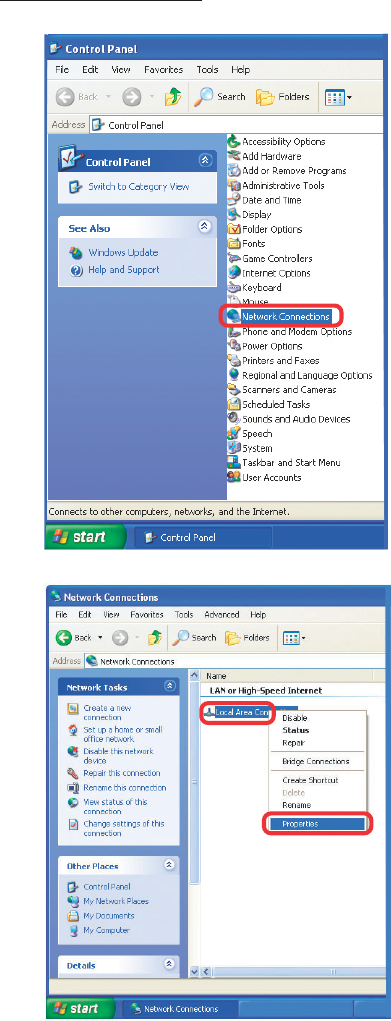
79
Networking Basics
Assigning a Static IP Address in Windows XP/2000
Double-click on
Network
Connections.
Single-click on
Properties.
Right-click on Local Area
Connections.
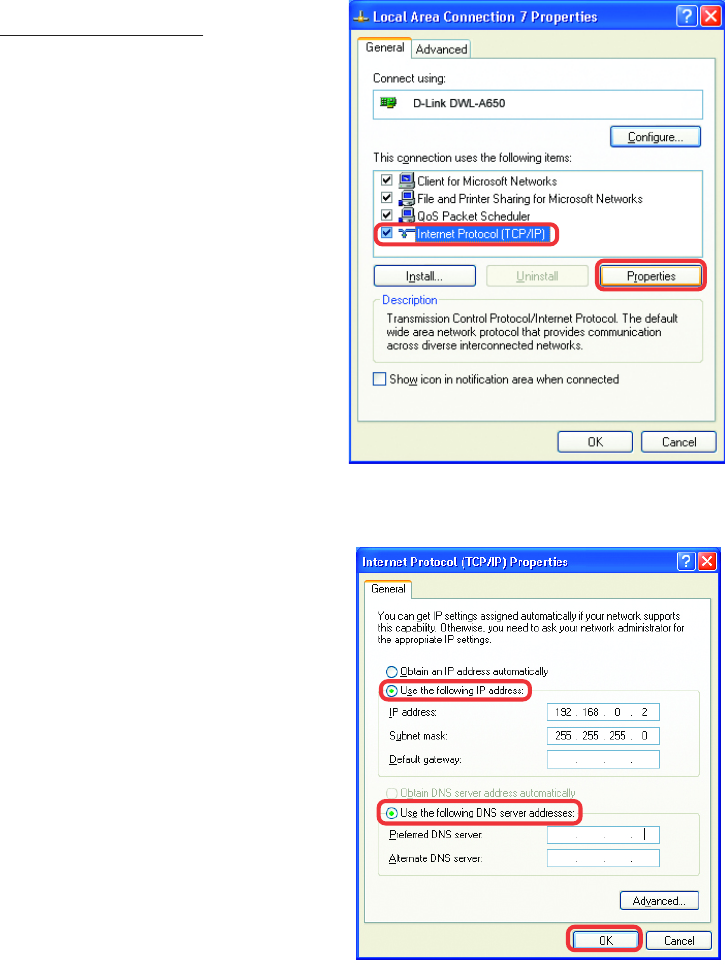
80
Networking Basics
Assigning a Static IP Address
in Windows XP/2000
Input your IP address and
subnet mask. (The IP
Addresses on your network
must be within the same
range. For example, if one
computer has an IP Address
of 192.168.0.2, the other
computers should have IP
Addresses that are
sequential, like 192.168.0.3
and 192.168.0.4. The subnet
mask must be the same for
all the computers on the
network.)
Input your DNS server
addresses. (Note: If you
are entering a DNS
server, you must enter the
IP Address of the Default
Gateway.)
The DNS server information will be supplied
by your ISP (Internet Service Provider).
Click OK.
Click on Internet
Protocol (TCP/IP).
Click Properties.
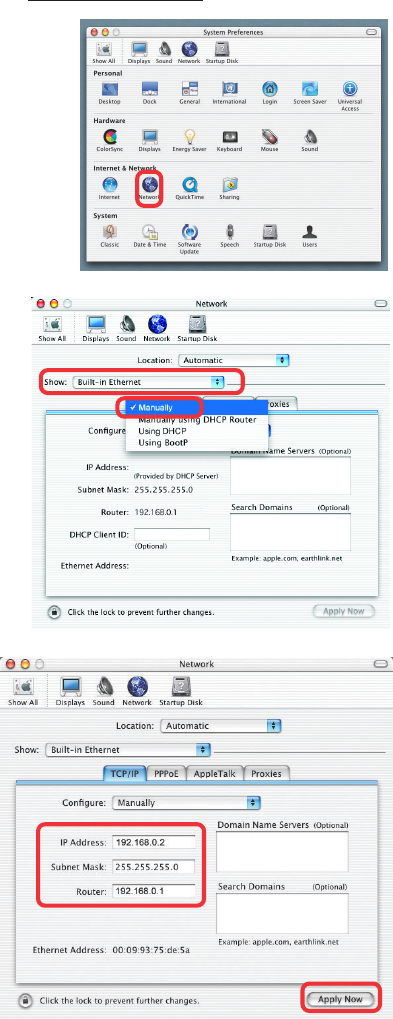
81
Networking Basics
Assigning a Static IP Address with Macintosh OSX
Go to the Apple Menu and se-
lect System Preferences.
cClick on Network.
Select Built-in Ethernet in the
Show pull-down menu.
Select Manually in the Con-
figure pull-down menu.
Input the Static IP Address,
the Subnet Mask and the
Router IP Address in the ap-
propriate fields.
Click Apply Now.
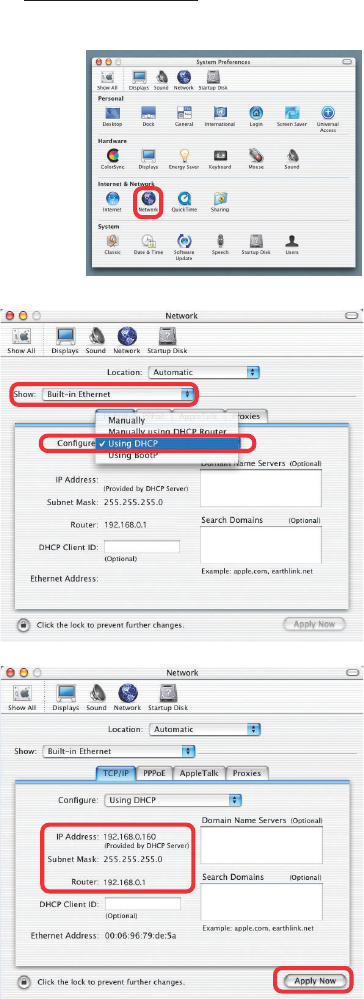
82
Networking Basics
Selecting a Dynamic IP Address with Macintosh OSX
Go to the Apple Menu and select
System Preferences.
Click on Network.
Select Built-in Ethernet in the
Show pull-down menu.
Select Using DHCP in the
Configure pull-down menu.
Click Apply Now.
The IP Address, Subnet
mask, and the Router’s IP
Address will appear in a few
seconds.
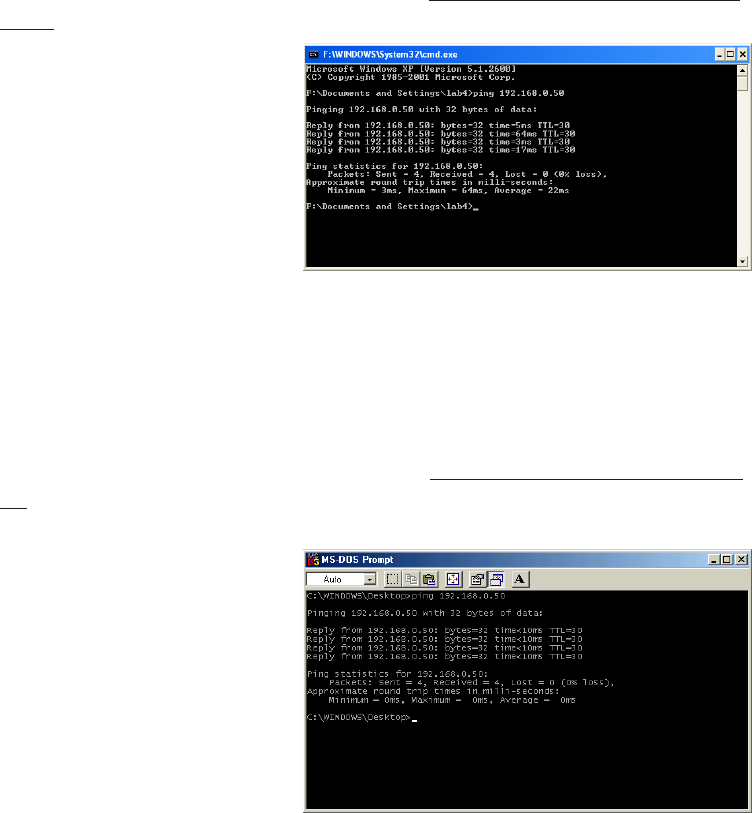
83
Networking Basics
Checking the Wireless Connection by Pinging in Windows XP and
2000
Checking the Wireless Connection by Pinging in Windows Me and
98
Go to Start > Run >
type cmd. A window
similar to this one
will appear. Type
ping
xxx.xxx.xxx.xxx,
where xxx is the IP
Address of the
Wireless Router or
Access Point. A
good wireless
connection will show
four replies from the
Wireless Router or
Acess Point, as
shown.
Go to Start > Run
> type command.
A window similar to
this will appear.
Type ping
xxx.xxx.xxx.xxx
where xxx is the IP
Address of the
Wireless Router or
Access Point. A
good wireless
connection will
show four replies
from the wireless
router or access
point, as shown.

84
Networking Basics
Adding and Sharing Printers in Windows XP
After you have run the Network Setup Wizard on all the computers in your network
(please see the Network Setup Wizard section at the beginning of Networking Basics),
you can use the Add Printer Wizard to add or share a printer on your network.
Whether you want to add a local printer (a printer connected directly to one computer),
share an LPR printer (a printer connected to a print server), or share a network
printer (a printer connected to your network through a Gateway/Router), use the Add
Printer Wizard. Please follow the directions below:
First, make sure that you have run the Network Setup Wizard on all of the computers
on your network.
On the following pages, we will show you these 3 ways to use the Add Printer Wizard:
1. Adding a local printer
2. Sharing an network printer
3. Sharing an LPR printer
For help with other tasks, that we have not covered here, in home or small office net-
working, see Using the Shared Documents folder and Sharing files and folders in
the Help and Support Center in Microsoft Windows XP.
(Other Networking Tasks)
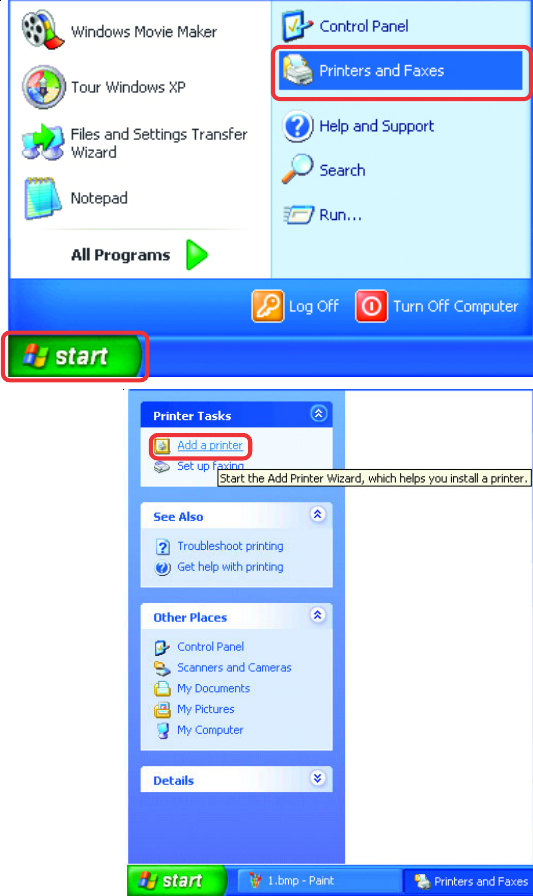
85
Networking Basics
Adding a local printer (a printer connected directly to a computer)
A printer that is not shared on the network and is connected directly to one computer
is called a local printer. If you do not need to share your printer on a network, follow
these directions to add the printer to one computer.
Go to Start
> Printers
and Faxes
Click on Add a printer.

86
Networking Basics
Adding a local printer
Click Next.
Select Local printer
attached to this
computer.
(Deselect Automati-
cally detect and install
my Plug and Play
printer if it has been
selected.)
Click Next.
Select Use the follow-
ing port:
From the pull-down menu
select the correct port
for your printer.
(Most computers use the LPT1: port,
as shown in the illustration.)
Click Next.
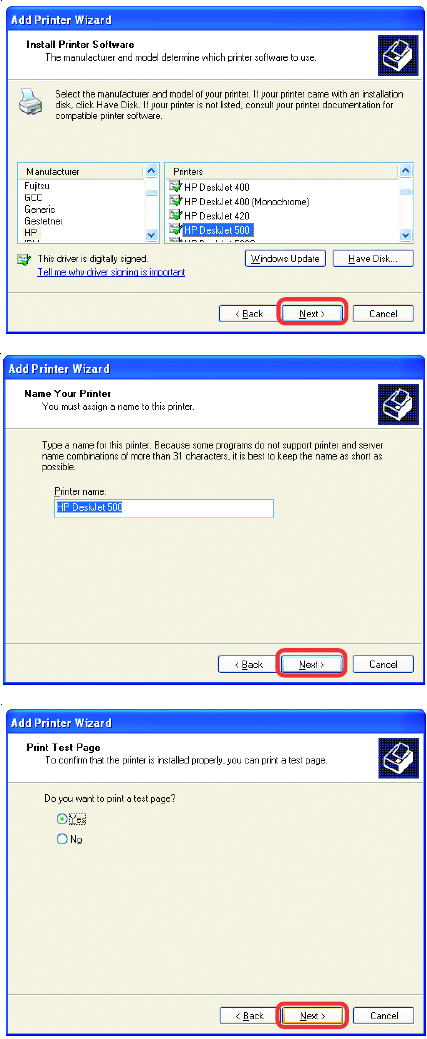
87
Networking Basics
Adding a local printer
Select and highlight
the correct driver for
your printer.
Click Next.
(If the correct driver is
not displayed, insert the
CD or floppy disk that
came with your printer
and click Have Disk.)
At this screen, you
can change the name
of the printer (optional).
Click Next.
Select Yes, to print a
test page. A successful
printing will confirm that
you have chosen the
correct driver.
Click Next.
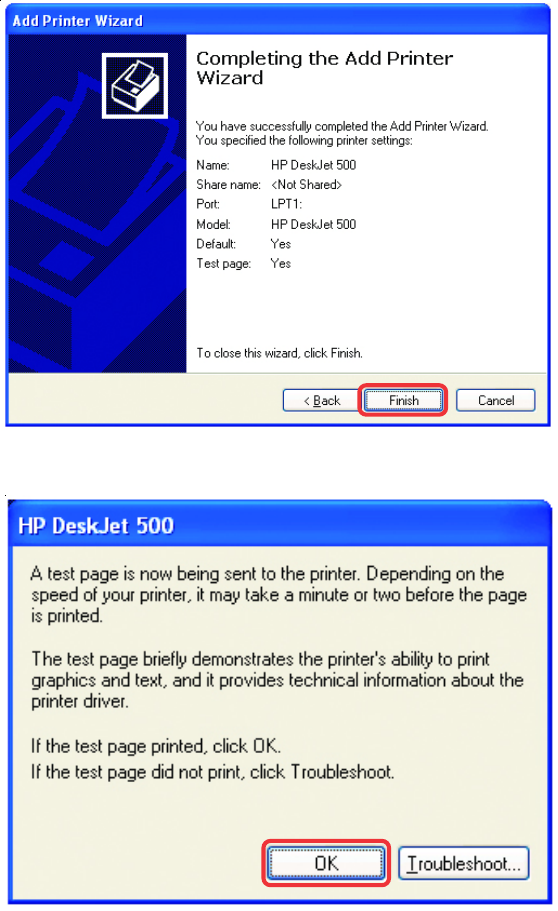
88
Networking Basics
Adding a local printer
This screen gives you information about your printer.
Click Finish.
When the test page has printed,
Click OK.
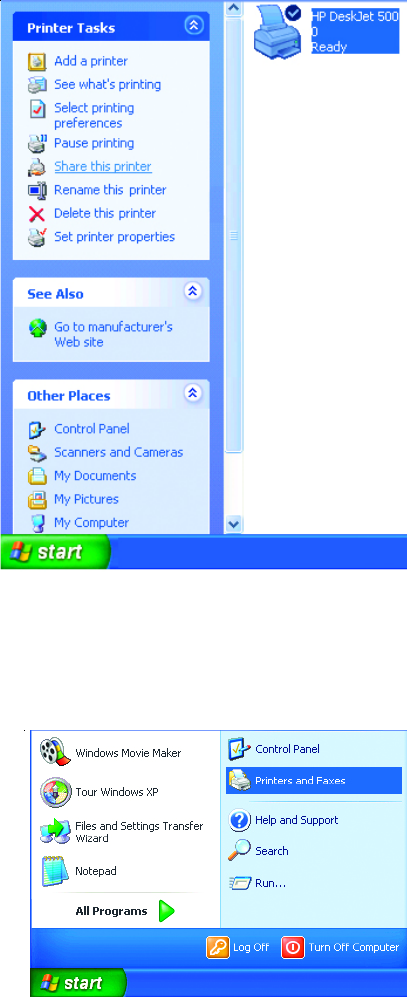
89
Networking Basics
Adding a local printer
Go to Start > Printers
and Faxes.
A successful installation will display
the printer icon as shown at right.
You have successfully added a local
printer.
Sharing a network printer
After you have run the Network Setup Wizard on all the computers on your network,
you can run the Add Printer Wizard on all the computers on your network. Please
follow these directions to use the Add Printer Wizard to share a printer on your
network:
Go to Start >
Printers and Faxes
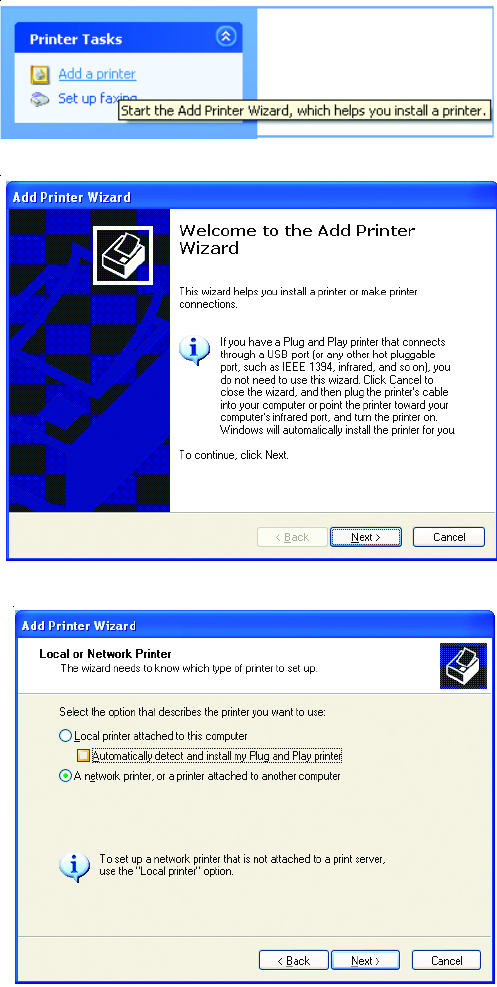
90
Networking Basics
Sharing a network printer
Click on
Add a printer.
Click Next.
Select
Network Printer.
Click Next.
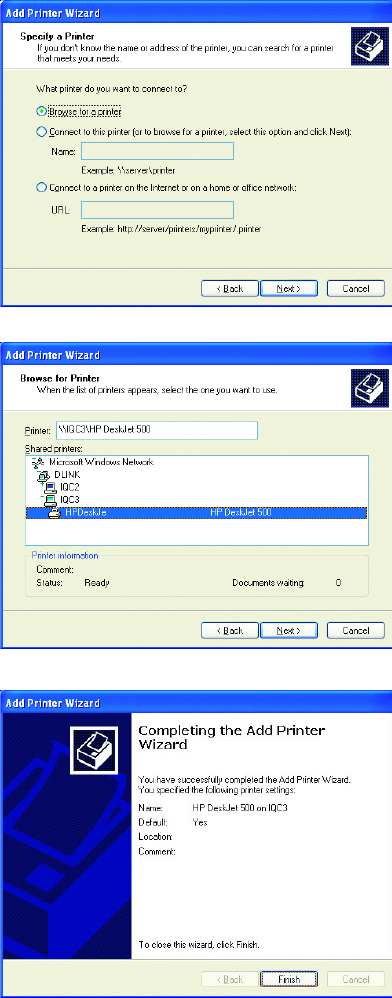
91
Networking Basics
Sharing a network printer
Select Browse for
a printer.
Click Next.
Select the printer you
would like to share.
Click Next.
Click Finish.